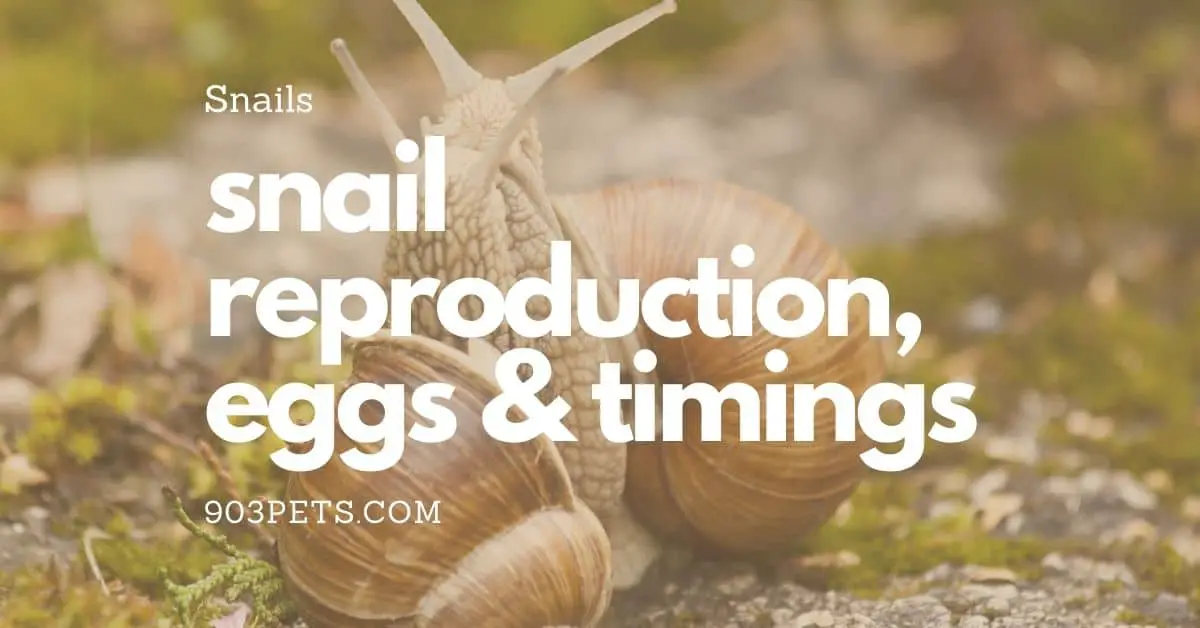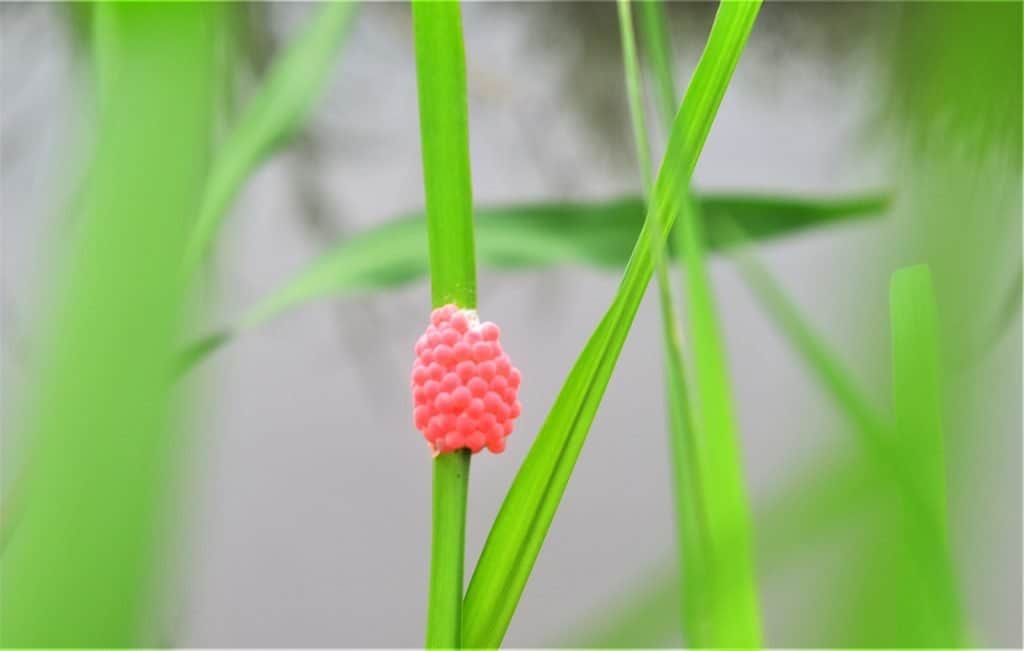Snail Reproduction, Snail Eggs, Snail Hatching Times
Snails are found all around the world and there are over 800 different species of snails. Some are small, like the garden snail, and some can be bigger than your hand!
If you have snails as pets, you may find yourself with snail eggs at some point. How long before they hatch? What should you do when you see snail eggs?
Let’s look at these questions and answer all your questions about snail reproduction.

Snail Reproduction
Snails are hermaphrodites, meaning they have both male and female reproductive organs. As such, snails often reproduce asexually by putting out what we call “love darts” which is a type of sperm that is stored in the snail’s head. Snails can live up to 10 years.
When it comes to reproduction, snails demonstrate three types, male-female pairing, asexual, hermaphrodite.
Male/Female Pairing
Snails of the same species can mate with each other and lay eggs that will hatch as baby snails. This is the type of reproduction we are most familiar with.
Heterosexual snail reproduction involves the joining of a male and female. The two snails will vibrate their rear ends together in a mating dance. They will then shoot out love darts that are used to impregnate each other as birds and bees do.
The pair will then find a good place for them to lay their eggs.
Asexual Reproduction
Some snails can reproduce without another snail. This is called asexual reproduction, which includes parthenogenesis and viviparous budding. Asexual reproduction happens when the offspring develops from an unfertilized female egg without sexual fertilization. In asexual reproduction the is no fusion of male and female gametes.
Budding is the process when a newborn snail carries the egg of a female inside its body. The embryo will grow inside the newborn and eventually emerge when it is fully developed.
Parthenogenesis is reproduction by an unfertilized ovum or embryo, in contrast to “viviparous,” which denotes development in a uterus and thus requires fertilization.
Hermaphrodite
Some snails are hermaphrodites, which means they have both male and female reproductive organs. They can impregnate themselves or another snail of their species.
Unlike asexual reproduction, eggs are fertilized inside the same snail from both male and female cells.
Advantages of asexual reproduction
There are a few advantages for snails that can reproduce through asexual reproduction.
- If the environment is not suitable for mating, it can still reproduce.
- The offspring may have better survival skills due to a lack of competition from other snail species.
- It’s much easier because there are no males involved with sexual intercourse and pregnancy to contend with.
- Some snails that normally have both male and female reproductive organs can undergo an operation to remove their male reproductive parts. This is the case with Pot-Bellied Garden Snails, which are hermaphrodites.
Disadvantages of asexual reproduction
Some snails that reproduce via parthenogenesis and viviparous budding have some disadvantages to this type of reproduction.
The primary disadvantage of asexual reproduction is that the offspring are not very diverse in appearance and are more prone to the transmission of hereditary diseases.
As a result, asexual snails are unable to evolve in response to environmental changes.
What Do Snail Eggs Look Like?
Snail eggs can be very small, much smaller than ant eggs. A few snails even lay no eggs at all! Those that do lay eggs have a wide range of sizes and shapes.
Some snail species release large numbers of tiny eggs in the wild and a single egg sac may contain up to thousands of eggs.
Most species of snails lay eggs that are translucent. An egg sac may look like tapioca. Other species lay white eggs.

Where Do Snails Lay Their Eggs?
Snails that lay eggs have to find a place to lay their eggs. They normally deposit them on water plants, in plant leaves, or among aquatic vegetation. In particular, you’ll often find snail eggs under plant leaves.
Snails favor larger broad-leaf plants, but they can also lay eggs in smaller plants, and even in algae. Snails that lay eggs can deposit dozens of egg capsules anywhere from 30 to 300 feet away from their original location.
Most freshwater snails tend to bury their eggs deep in the mud while marine snails usually just leave it floating at the surface of the ocean.
Some snails like Rock Snail and Giant African Snail lay their eggs in moist soil.
What Happens to Snail Eggs?
The number of offspring produced by a snail may vary depending on its species. For example, some snails may produce anywhere from 10 to 500 eggs per batch, while others only have 1-2 offspring at a time (such as the case with
What To Do If Your Snail Lays Eggs
If your snail lays eggs, leave them in the tank. No need to transfer them into another tank for hatching. It’s much safer just to leave it where the egg is laid and let nature take its course.
You won’t be able to see or feel little snails inside an egg capsule until they hatch. You’ll have to wait for that to happen!
You may not even know your snail is pregnant if it’s a self-impregnating hermaphrodite.
If you must move the eggs, you should let them sit for 30-40 days before moving them from their area into another tank where they will hatch. You don’t want to move them right away because you can accidentally rupture the eggs while handling them.
You can also get creative with some snails that lay their eggs above ground and place them on a moist paper towel. Make sure the eggs are completely covered with water so they can continue to develop properly in that environment.
What Is The Hatching Time For Snail Eggs?
There is no certain amount of time for snails to hatch. It depends on factors such as temperature, species of snail, and conditions in which the eggs are kept.
Hatchling snails may live for 1-2 years and may grow up to 0.5 inches in size! They can feed on algae, fish food flakes, or other plant material that’s rich in calcium. This allows them to build their shells rapidly without sacrificing shell quality.
Mediterranean pond snails hatch at 2-3 months, land snails hatch at 3-4 months, African giant snails take a whopping 6 months to hatch, while Ramshorn snail eggs require 4-5 weeks to develop.
The Bottom Line
You don’t necessarily have to worry if your tank has an infestation of snail eggs. There are a number of pre-existing natural controls that will keep your tank clean and free of snails.
If you prefer to manually remove the eggs, they can be easily removed by hand or scooped out with a net. There is no need for you to overdo it, since the number of eggs laid may not pose serious threats under normal conditions.
Snail eggs are essential for the reproduction of various species of snails.
They also play an important role in aquatic ecosystems because they host a number of tiny aquatic organisms and plants, which serve as food to a number of other animals such as fish, leeches, and insects.
So if you see your snail laying eggs in its tank, just leave them there!
If you think your pet is ill, call a vet immediately. All health-related questions should be referred to your veterinarian. They can examine your pet, understand its health history, and make well informed recommendations for your pet.
903pets.com Staff



![Insect Pets - Which Insects Make The Best Pets? [12 Answers] 5 Insect Pets – Which Insects Make The Best Pets? [12 Answers]](https://cdn-0.903pets.com/ifywhoft/2022/01/insect-pets-are-they-right-for-you-768x402.jpg)

![Praying Mantis Egg Cases - Buyers Guide [Info & Tips] 9 Praying Mantis Egg Cases – Buyers Guide [Info & Tips]](https://cdn-0.903pets.com/ifywhoft/2022/05/praying-mantis-egg-cases-buyers-guide-768x402.jpg)
![Do Praying Mantis Make Good Pets? [Pros & Cons] 11 Do Praying Mantis Make Good Pets? [Pros & Cons]](https://cdn-0.903pets.com/ifywhoft/2021/04/Do-Praying-Mantis-Make-Good-Pets-768x402.jpg)
